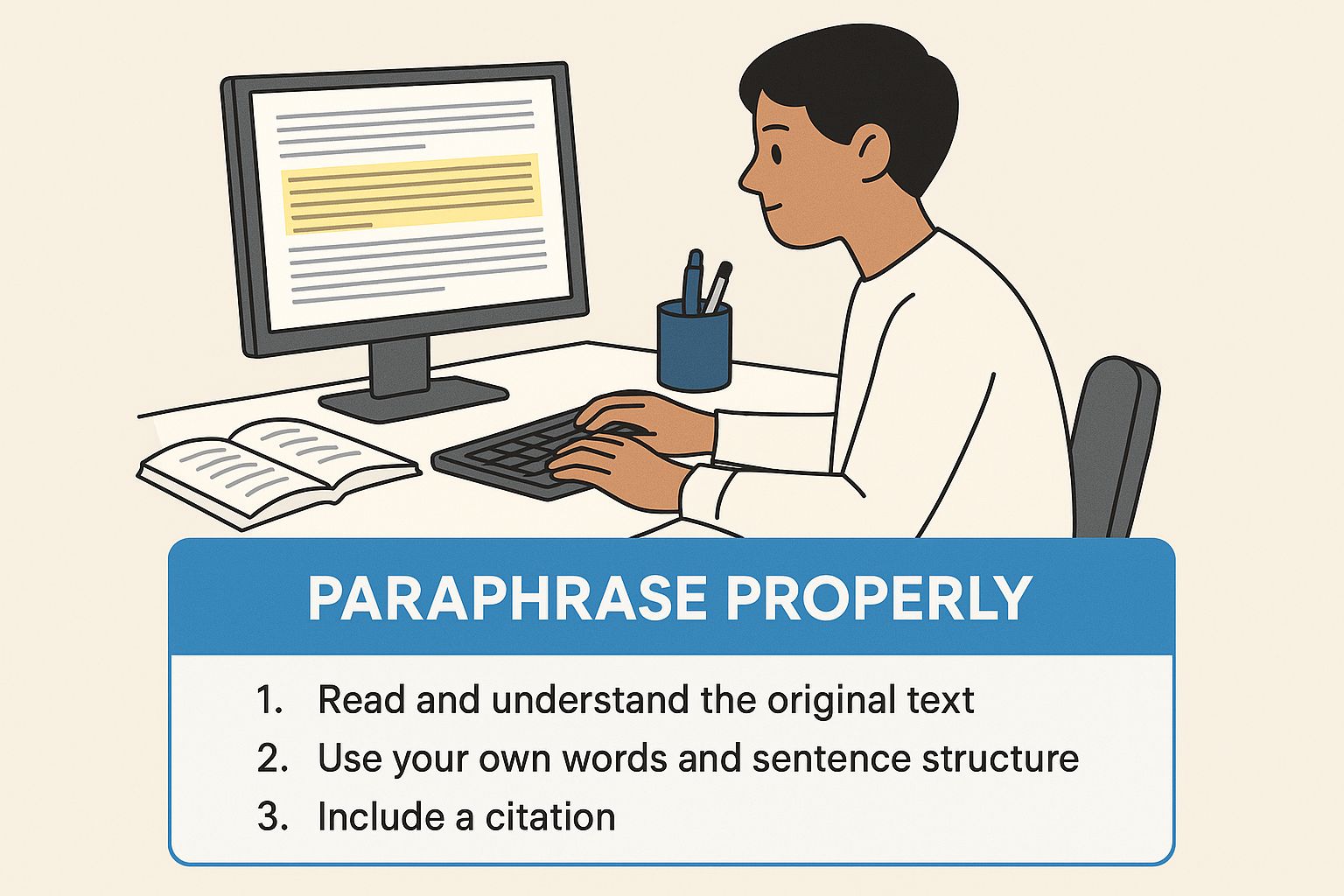The Hidden Reality of Campus Plagiarism
The pressure to succeed in college is immense. Unfortunately, this can lead students to plagiarism, a widespread issue on college campuses, often shrouded in secrecy. Plagiarism isn't just about directly copying and pasting. It takes many forms, some of which students might not even recognize as academic dishonesty. This lack of awareness, combined with easy access to online resources and the rise of AI tools, creates an environment where academic integrity is constantly challenged.
Understanding the Scope of the Problem
One of the most concerning aspects of plagiarism is its prevalence. It's easy to assume it's a minority issue, but data reveals a different story. A significant percentage of students admit to some form of academic dishonesty, including plagiarism, during their college years.
Research from the International Center for Academic Integrity found that 95% of students admitted to cheating on exams, homework, or through plagiarism at least once. Of undergraduates, 39% reported cheating on exams, and a staggering 62% admitted to cheating on written assignments. This widespread occurrence underscores the importance of understanding plagiarism and its consequences. Learn more about plagiarism statistics.
The Consequences: More Than Just a Failing Grade
The repercussions of plagiarism go far beyond a failing grade. Depending on the severity and the institution's policies, consequences can range from suspension to expulsion. Even a single instance can tarnish a student's academic record, affecting graduate school admissions and job prospects. The emotional toll can also be significant, leading to shame, anxiety, and a loss of trust within the academic community.
Technology's Double-Edged Sword
The digital age presents both challenges and opportunities for academic integrity. The internet offers a wealth of information, but it also makes copying and pasting without attribution easier. This ease of access is tempting, especially under pressure. However, technology also provides plagiarism-detection tools. Institutions increasingly utilize sophisticated software like Turnitin to identify academic dishonesty, making the chances of getting caught higher than ever. Navigating the digital world responsibly and ethically is crucial for every college student.
Spotting Plagiarism Traps Before They Catch You

Not all plagiarism involves directly copying and pasting. In fact, many common forms are subtle and can easily trap unsuspecting students. Understanding these different types is crucial for avoiding plagiarism in college. This means being aware of the various ways academic dishonesty can appear, from the obvious to the less apparent.
Common Plagiarism Pitfalls
-
Direct Plagiarism: This is the most blatant form. It involves copying text word-for-word without attribution. This includes lifting sentences, paragraphs, or even entire pages from a source and presenting them as your own.
-
Mosaic Plagiarism: This involves patching together phrases and sentences from different sources, creating a "mosaic" of borrowed work. Even if you change a few words, it's still plagiarism if the core ideas and structure aren't original.
-
Self-Plagiarism: Reusing your own previous work without permission is also plagiarism. Submitting the same paper for different classes, or even reusing sections of a previous essay, can have serious consequences.
-
Accidental Plagiarism: This happens when students unintentionally misrepresent source material. This can be due to poor paraphrasing, incorrect citations, or simply forgetting to cite a source. While unintentional, the consequences can be the same as intentional plagiarism.
Recognizing the Gray Areas
Beyond these clear-cut examples, several gray areas can confuse even the most diligent students. Collaboration, for example, is often encouraged in college. However, knowing where collaboration ends and plagiarism begins is essential. Sharing notes or brainstorming together is acceptable, but submitting work that's too similar to a classmate's can be problematic.
Paraphrasing is another tricky area. Simply changing a few words doesn't make a passage your own. You need to restructure the information and express it in your own voice. Additionally, plagiarism remains a significant issue, with 29% of high school students and 28% of college students involved in plagiarism. This data highlights the importance of vigilance and understanding proper citation techniques. Find more detailed statistics here.
Protecting Yourself With Knowledge
By understanding these different types of plagiarism and the situations that can lead to unintentional violations, you can develop a keen awareness of potential pitfalls. This knowledge empowers you to navigate the complexities of academic writing with confidence and integrity. This awareness is crucial, not only for avoiding penalties but also for developing strong research and writing habits that will benefit you throughout your academic career and beyond.
Mastering Citations Like a Pro
Citing sources correctly isn't just about following the rules; it's about demonstrating academic integrity and giving credit where it's due. It's also your best defense against plagiarism accusations. Understanding how and when to cite transforms this task from a chore into a valuable tool that strengthens your academic work. You might be interested in: How to master citations with a generator.
Demystifying Citation Styles
Several citation styles are commonly used in college, including APA, MLA, and Chicago. Each style has unique formatting rules for in-text citations and bibliographies. Understanding these differences is crucial for accurately attributing sources and presenting your work professionally.
When to Cite: A Clear Guide
Knowing when to cite is as important as knowing how. Cite any information that isn't common knowledge. This includes direct quotes, paraphrased material, and even ideas drawn from external sources. Citing correctly demonstrates academic honesty and builds credibility.

The infographic above shows a student working on their computer, emphasizing the importance of proper paraphrasing and attribution. Even when you rephrase information in your own words, acknowledging the original source is essential to avoid plagiarism.
Weaving Sources Into Your Writing
Effective citation goes beyond simply avoiding plagiarism; it's about integrating sources seamlessly into your writing. Use quotations strategically to support your arguments and paraphrase effectively to present information in your own voice. This allows you to build upon existing research while contributing your unique perspective.
To help illustrate the different citation styles, the following table provides a comparison of their key features:
Citation Style Comparison Guide
A comprehensive comparison of major citation styles used in college, showing format differences for common source types.
| Citation Style | In-Text Citation Format | Bibliography Format | Common Disciplines | Key Features |
|---|---|---|---|---|
| APA (American Psychological Association) | (Author, Year, p. #) | Author, A. A. (Year). Title of work. Publisher. | Social Sciences, Education, Psychology | Emphasis on date of publication; uses author-date system |
| MLA (Modern Language Association) | (Author #) | Author, A. A. Title of Work. Publisher, Year. | Humanities, Literature, Languages | Focuses on authorship; uses author-page system |
| Chicago (Chicago Manual of Style) | Footnotes/Endnotes | Bibliography or Notes | History, Art, Music | Offers flexibility with footnotes/endnotes and bibliography options; often uses ibid. |
This table highlights the core differences between these citation styles, enabling you to choose the appropriate format for your academic work. Understanding these distinctions is essential for presenting your research professionally.
Handling Tricky Sources and Multiple Authors
Some sources, such as social media posts or online videos, can be challenging to cite correctly. Similarly, citing sources with multiple authors requires careful attention to formatting. Learning to handle these complexities ensures accuracy and completeness in your citations.
Real Examples and Common Mistakes
Practical examples and step-by-step walkthroughs can provide a deeper understanding of citation best practices. Learning from common mistakes helps avoid potential pitfalls and builds confidence in your ability to cite sources accurately and ethically. This knowledge is essential for academic success.
Building Research Systems That Prevent Problems

Many instances of plagiarism in college occur unintentionally during the research phase. Students can easily lose track of their sources or struggle to differentiate their own ideas from borrowed material. This section explores proven organizational systems to help you avoid plagiarism from the start of your research process. These systems not only protect your academic integrity but also enhance your overall research and writing skills.
Organizing Your Sources: The Foundation of Avoiding Plagiarism
Developing a robust system for managing your sources is critical. This means meticulously recording every piece of information you gather.
- Author(s) or Creator(s): Note everyone involved.
- Title of the Work: Record the full and accurate title.
- Publication Date: Include the date, especially important for APA style.
- Publisher or Source: Identify the publisher (for books or journals) and the website (for online content).
- Page Numbers (if applicable): Note page numbers for direct quotes and paraphrased information.
- URL (for online sources): Record the full URL.
This detailed record-keeping might seem tedious, but it’s your best defense against accidental plagiarism.
Note-Taking Methods That Work
How you take notes is crucial for avoiding plagiarism. Here are a few proven strategies:
- Direct Quotes: Enclose direct quotes in quotation marks and immediately cite the source.
- Paraphrasing: Rephrase information in your own words and immediately cite the source. Ensure you change both the wording and sentence structure.
- Summarizing: Briefly capture the main points in your own words and cite the source.
- Separate Your Ideas: Maintain a separate section for your own thoughts and analyses.
Digital Tools and Analog Methods
Choose the method that best suits your learning style:
- Digital Note-Taking Apps: Apps like Evernote, Notion, or OneNote offer features like tagging, linking, and cloud storage.
- Traditional Note Cards: The physical act of writing can aid memory and comprehension. Color-coding cards can further enhance organization.
- Annotated Bibliographies: Creating an annotated bibliography provides a structured approach to summarizing and evaluating each source.
Managing Large Research Projects
For larger projects, consider these additional strategies:
- Create a Research Log: A spreadsheet or document dedicated to tracking your sources, notes, and progress can be invaluable.
- Develop a Consistent Naming Convention: Use a logical system for naming files and folders.
By building these research systems and choosing the right tools, you transform plagiarism avoidance from a daunting task into a manageable process. This organized approach protects your academic integrity and streamlines your workflow, strengthening your research skills. This provides the foundation for producing original, well-supported academic work and develops strong research habits for your future.
The Science of Effective Paraphrasing
Paraphrasing, while seemingly simple, requires a deeper understanding of the source material and how to effectively convey its ideas. Many students mistakenly think just changing a few words is enough. However, true paraphrasing involves a more substantial transformation of the original text while keeping its core meaning intact. This section explores the key steps to effective paraphrasing, helping you avoid plagiarism and cultivate your own academic voice. You might also be interested in: How to master paraphrasing.
Understanding the Core Principles
Effective paraphrasing isn't about substituting synonyms; it's about transforming ideas. This involves internalizing the source material’s meaning and then expressing it in your own unique style. This process demands careful reading, critical analysis, and strong writing skills.
The Step-by-Step Paraphrasing Process
-
Read and Comprehend: Start by carefully reading the source material to fully grasp its meaning. Pinpoint the central arguments and supporting evidence.
-
Put the Original Aside: Once you understand the text, set it aside. This helps prevent accidental copying and promotes original thinking.
-
Write in Your Own Words: Now, write the information as you understand it, using your own vocabulary and sentence structure. Try explaining the concept as if you were teaching it to someone.
-
Compare and Contrast: Check your paraphrase against the original source. Ensure you've accurately represented the meaning without simply replicating the phrasing.
-
Cite the Source: Always cite the original source, even if you've paraphrased. This acknowledges the author's work and prevents plagiarism.
Choosing Between Quotes and Paraphrases
While paraphrasing is generally preferred, direct quotes have their value. Use direct quotes when the original language is especially powerful, distinctive, or concise. However, overusing quotes can disrupt the flow of your writing. Aim for a balance between paraphrasing and quoting to create a cohesive and original piece.
Avoiding Paraphrasing Pitfalls
One common mistake is patchwriting, which involves swapping out words without changing the sentence structure. This is still considered plagiarism. Another error is relying too heavily on synonyms, which can result in unnatural phrasing and misrepresent the original meaning. Effective paraphrasing involves presenting the idea in a new and original manner.
Practice Makes Perfect
Paraphrasing is a skill honed through practice. By consistently applying these techniques, you’ll improve your ability to interact with sources effectively while upholding academic integrity. Mastering paraphrasing not only protects you from plagiarism, but also allows you to synthesize information and present complex ideas clearly and confidently, ultimately strengthening your writing.
Navigating AI Tools and Digital Age Challenges
The increasing presence of Artificial Intelligence (AI) writing tools presents a significant challenge to academic integrity. These tools can be useful for tasks like brainstorming or checking grammar, but they also create new opportunities for plagiarism. This requires a change in how we understand and address plagiarism in education. Simply avoiding copying and pasting isn't enough anymore; students must now learn to navigate the ethical ambiguities surrounding AI assistance.
The Ethical Use of AI in Academics
AI tools can be valuable resources for research and writing, as long as they're used ethically. Consider AI as a powerful research assistant: it can help gather information, organize your thoughts, and even polish your writing. However, just like a human research assistant, AI shouldn't be doing the actual thinking and writing for you. Your original ideas and voice should always remain central to your work. You might be interested in: How to master ethical AI usage in college.
Understanding Institutional Policies
Each university and college maintains its own policies on using AI tools in academic work. Some institutions might strictly prohibit using AI for writing assignments, while others may allow limited use for certain tasks. It's essential to understand your institution's specific guidelines to ensure you're in compliance and avoid unintended violations. Not knowing the rules is no excuse.
Leveraging Technology Responsibly
AI-powered plagiarism checkers, such as Grammarly, can be helpful learning resources. These platforms can detect potential plagiarism in your writing, allowing you to correct any issues before submitting your work. This helps guarantee originality and upholds academic integrity. Global plagiarism trends also highlight the changing landscape of academic dishonesty. For instance, from 2019 to 2020, the global average plagiarism rate increased by 28.06%, going from 14.67% to 18.79%. This jump was likely influenced by both the pandemic and the rise in access to digital tools. Explore this topic further.
Adapting to New Detection Methods
As students find new ways to use technology, educators are adapting their detection methods as well. Many instructors now employ advanced plagiarism detection software that can identify AI-generated text. Submitting AI-generated content as your own work is not only unethical, but it’s also increasingly likely to be caught.
The Future of Academic Integrity
The relationship between AI and education is constantly evolving. Staying informed about the latest developments, best practices, and ethical considerations surrounding AI use is crucial for academic and professional success. By using technology responsibly and upholding a commitment to original thought, you can harness the potential of AI while maintaining the highest standards of academic integrity. This protects your academic record and builds essential skills for lifelong learning and career advancement.
Creating Lifelong Academic Integrity Habits
Academic integrity isn't simply about avoiding plagiarism in college. It's about developing a mindset and practices that will benefit you throughout your academic and professional life. Building these habits now will make ethical, honest work a natural part of your process. This, in turn, will result in higher-quality work that genuinely reflects your abilities and insights.
Time Management: Your First Line of Defense
One of the biggest factors that leads to plagiarism is poor time management. When deadlines approach and the pressure increases, it can be tempting to take shortcuts. However, if you prioritize effective time management, you can eliminate the need to compromise your integrity.
-
Plan Ahead: Break down large assignments into smaller, more manageable tasks. This approach prevents last-minute panic and reduces the temptation to plagiarize.
-
Create a Realistic Schedule: Avoid overcommitting. A well-paced schedule allows time for in-depth research, careful writing, and accurate citations – all key components of academic integrity.
-
Prioritize Tasks: Determine the most crucial assignments and dedicate adequate time to them. This helps you avoid feeling overwhelmed and resorting to plagiarism out of desperation.
Developing Confidence in Your Own Ideas
Students sometimes plagiarize because they lack confidence in their own thoughts and perspectives. Cultivating belief in your own abilities is essential for upholding academic integrity.
-
Embrace Your Perspective: Your unique viewpoint is valuable. Every student brings a different perspective to the table, and your individual thoughts and interpretations enrich academic discussions.
-
Engage Actively with Material: Ask questions, analyze concepts, and develop your own opinions. The more deeply you understand the material, the more comfortable you’ll feel expressing your own ideas about it.
-
Practice Makes Perfect: The more you write and share your ideas, the more confident you'll become in your ability to produce original work.
Collaborative Work: Maintaining Individual Accountability
Collaboration offers valuable learning opportunities, but requires careful planning to prevent plagiarism.
-
Clear Communication: Establish clear expectations and boundaries with your group members from the beginning. Define what constitutes acceptable collaboration and what crosses the line into plagiarism.
-
Individual Contributions: Make sure each member contributes their own original thoughts and work. Simply dividing a paper into sections and compiling them without proper integration can lead to plagiarism.
-
Review and Revision: Before submitting group work, thoroughly review the entire document. Ensure that all sources are cited correctly and that individual contributions are clearly distinguishable.
Handling Challenging Situations
Even with the best of intentions, students may face difficult academic circumstances. Knowing how to handle these challenges ethically is essential.
-
Impossible Deadlines: If you encounter an unmanageable deadline, communicate with your instructor as soon as possible. Explain your situation and request an extension. Honesty is always preferable to resorting to plagiarism.
-
Difficult Source Material: If you struggle to grasp complex material, don't hesitate to seek assistance. Consult with your instructor, a teaching assistant, or a librarian. A clear understanding of the material is crucial for both ethical and successful academic work.
To help you track your progress and stay on top of best practices, consider using a habit tracker. The table below provides a helpful framework.
Academic Integrity Habit Tracker
A practical checklist of daily and weekly habits that support academic integrity and prevent plagiarism.
| Habit Category | Daily Practices | Weekly Reviews | Red Flag Warnings | Success Indicators |
|---|---|---|---|---|
| Time Management | Allocate specific time slots for research and writing. | Review your schedule and adjust as needed. | Consistently missing deadlines. | Completing assignments on time. |
| Source Use | Note down source information as you research. | Double-check citations and references. | Relying heavily on one or two sources. | Using a variety of credible sources. |
| Note-Taking | Paraphrase information in your own words. | Review notes and ensure clear attribution of sources. | Large chunks of text copied directly from sources. | Notes reflect your understanding of the material. |
| Collaboration | Communicate clearly with group members about individual contributions. | Review group work for proper integration and citation. | Unequal contribution of work within a group. | All group members actively participate and contribute unique work. |
| Self-Reflection | Evaluate your understanding of academic integrity principles. | Reflect on your research and writing processes. | Feeling tempted to take shortcuts. | Confidence in producing original, ethical work. |
By reviewing this tracker regularly, you can proactively address potential issues and reinforce good habits.
Building Lifelong Habits
Academic integrity is an ongoing process, not a one-time achievement. By incorporating these practices into your routine, you’ll build habits that extend far beyond college. This consistent commitment to ethical work will be a valuable asset throughout your academic and professional career.
